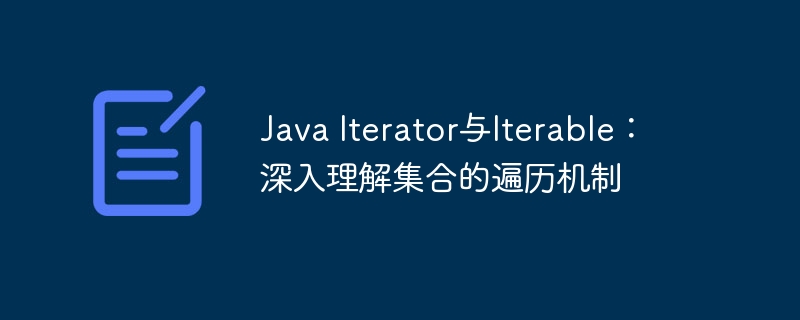Home >Java >javaTutorial >Java Iterator and Iterable: In-depth understanding of the traversal mechanism of collections
Java Iterator and Iterable: In-depth understanding of the traversal mechanism of collections
- WBOYWBOYWBOYWBOYWBOYWBOYWBOYWBOYWBOYWBOYWBOYWBOYWBforward
- 2024-02-20 12:00:32931browse

Java Iterator and Iterable: In-depth understanding of the traversal mechanism of collections In Java programming, collection traversal is a very common operation. In order to better understand the traversal mechanism of collections, we need to delve into the Iterator and Iterable interfaces in Java. This article will start with the definition, function and usage of these two interfaces, and lead you to gradually explore the principles and usage techniques of Java collection traversal. Let us learn in depth with PHP editor Strawberry and master the essence of Java collection traversal!
- Iterator interface: The Iterator interface defines the following methods:
- hasNext(): Returns a Boolean value indicating whether there are more elements in the collection.
- next(): Returns the next element in the collection. If there are no more elements in the collection, a NoSuchElementException exception is thrown.
- remove(): Delete the current element in the collection.
- Iterable interface: The Iterable interface defines an iteration method:
- iterator(): Returns an Iterator object for traversing the collection.
- Use Iterator and Iterable to traverse collections: Here are some examples of using Iterator and Iterable to iterate over collections:
// 使用Iterator遍历集合
List<Integer> list = new ArrayList<>();
Iterator<Integer> iterator = list.iterator();
while (iterator.hasNext()) {
Integer element = iterator.next();
// 对元素进行处理
}
// 使用foreach循环遍历集合
List<Integer> list = new ArrayList<>();
for (Integer element : list) {
// 对元素进行处理
}
- The difference between Iterator and Iterable: Iterator and Iterable are two different interfaces. Their main differences are:
- Iterator is a concrete class that provides methods for traversing collections.
- Iterable is a marker interface that represents a collection that can be iterated.
- When to use Iterator and Iterable: In practical applications, we can choose to use Iterator or Iterable according to the specific situation. Generally speaking, if we need fine-grained control over a collection, such as deleting elements or getting the index of the current element, we can use an Iterator. If we just need to iterate through the collection and process each element, we can use Iterable and foreach loop.
In short, Iterator and Iterable are two important components in the Java collection framework. They provide us with the basic mechanism for traversing collections. By understanding the principles and usage of these two interfaces, we can process collection data more efficiently.
The above is the detailed content of Java Iterator and Iterable: In-depth understanding of the traversal mechanism of collections. For more information, please follow other related articles on the PHP Chinese website!

